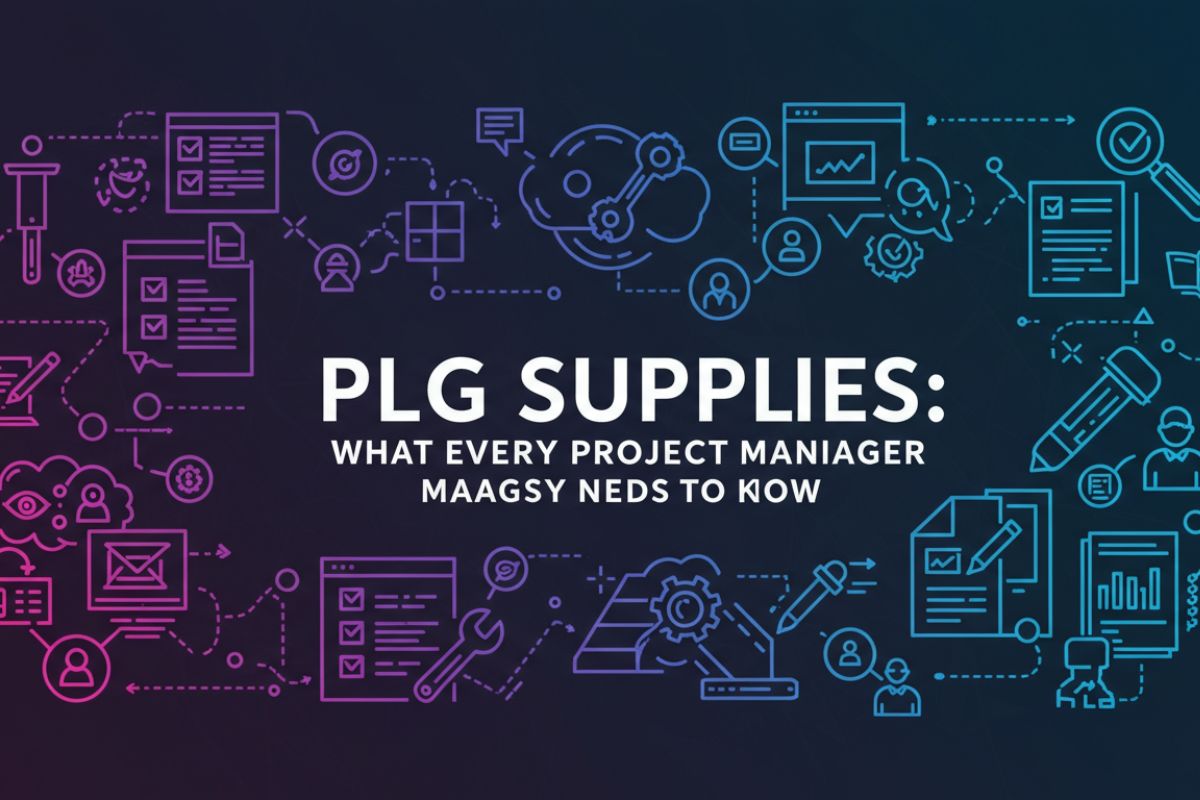In today’s fast-paced digital landscape, businesses are continuously seeking innovative ways to grow. Enter Product-Led Growth (PLG), a strategy that puts the product at the forefront of customer acquisition and retention. With this approach, products essentially sell themselves through an exceptional user experience and value proposition. But how do project managers navigate this transformative environment? It starts with equipping themselves with essential PLG supplies that streamline processes and enhance collaboration.
Understanding what tools are necessary is key for any project manager aiming to excel in a PLG Supplies framework. From data analysis software to robust communication platforms, ensuring you have the right resources can make all the difference in your project’s success. Let’s explore why these supplies matter and how they can help propel not just individual projects but entire organizations toward growth and innovation.
Defining PLG (Product-Led Growth)
Product-Led Growth (PLG) is a business strategy that prioritizes the product as the main driver of user acquisition, retention, and expansion. Unlike traditional growth models that rely heavily on sales teams or marketing campaigns, PLG leverages the product experience itself to attract users.
At its core, PLG focuses on creating tangible value for customers right from their first interaction with the product. This often includes offering free trials or freemium versions that allow potential users to explore features without any initial investment.
By emphasizing seamless onboarding and intuitive design, companies can foster organic word-of-mouth referrals. When users find genuine satisfaction in a product’s performance, they are more likely to share their experiences with others—driving further growth naturally. In this way, products not only serve as tools but also become integral components of a company’s marketing strategy.
Why PLG is vital for business success
In today’s competitive landscape, adopting a Product-Led Growth (PLG) strategy is no longer optional. It’s essential for businesses aiming to scale efficiently.
PLG focuses on delivering value through the product itself. This approach enables companies to attract users without heavy marketing investments. When your product speaks for itself, customer acquisition becomes smoother and more organic.
Moreover, PLG fosters deeper user engagement. Customers become advocates when they experience real benefits firsthand. This word-of-mouth can fuel growth exponentially.
Additionally, integrating feedback loops within the product helps refine features and enhance user satisfaction continuously. Companies embracing this iterative process can quickly adapt to market demands.
PLG nurtures a culture of innovation—encouraging teams to prioritize user needs and drive meaningful changes that resonate in the marketplace.
The role of a project manager in PLG
The project manager serves as the driving force behind a successful Product-Led Growth strategy. This role requires a blend of strategic vision and hands-on execution.
They must collaborate closely with cross-functional teams, ensuring that everyone is aligned toward common goals. This unity fosters an environment where product improvements can thrive based on user insights.
Project managers also play a crucial role in data interpretation. They analyze customer behavior to inform decisions about features and enhancements, creating products that resonate with users.
Additionally, they advocate for effective communication within the team and with stakeholders. By creating transparency around progress and setbacks, they build trust.
This dynamic position bridges gaps between technical development and market needs, paving the way for sustainable growth through exceptional user experiences.
Must-Have Supplies for a Project Manager in PLG:
A project manager steering a Product-Led Growth (PLG) strategy requires the right tools to navigate complexities. First on the list are collaboration tools. These platforms foster teamwork, allowing teams to brainstorm and share ideas seamlessly.
Next, data analysis software is essential. Understanding user behavior helps in making informed decisions that drive product improvements. Such insights can lead to higher customer satisfaction and retention rates.
Communication platforms cannot be overlooked either. Clear communication keeps everyone aligned on goals and timelines, reducing misunderstandings that could derail projects.
Incorporating customer feedback systems is vital. Gathering real-time feedback enables managers to adapt strategies quickly based on user needs and preferences. This responsiveness can significantly boost growth initiatives and enhance overall project success.
A. Collaboration Tools
Collaboration tools are the backbone of effective Product-Led Growth (PLG) strategies. They enable project managers to connect teams across different locations and time zones seamlessly.
Platforms like Slack, Trello, or Asana foster real-time communication. They allow team members to share ideas, track tasks, and provide updates instantaneously. This immediate feedback loop is crucial for maintaining momentum in PLG initiatives.
The right collaboration tools can also enhance transparency. Everyone involved can see progress and understand their roles clearly. This clarity helps prevent misunderstandings that could derail a project’s success.
Moreover, these tools often integrate with other software, creating a more streamlined workflow. By leveraging integrations, teams can automate mundane tasks and focus on what really matters—delivering value to users through innovative products.
With the right collaboration tools in place, project managers set the stage for thriving PLG environments where creativity flourishes and productivity soars.
B. Data Analysis Software
Data analysis software is a cornerstone for any project manager embracing PLG. It transforms raw data into actionable insights, allowing teams to understand user behavior and product performance.
With the right tools, you can track key metrics such as engagement rates, churn rates, and conversion funnels. This information helps identify bottlenecks or opportunities within your product lifecycle.
Popular options like Google Analytics or Mixpanel provide robust features tailored for interpreting user journeys. These insights guide decisions on feature enhancements and marketing strategies.
Moreover, integrating data visualization tools can make complex datasets more digestible. Visual representations help convey findings to stakeholders effectively.
Leveraging data analysis software not only informs strategy but also fosters a culture of continuous improvement across teams.
C. Communication Platforms
Effective communication is the backbone of any successful project. In a Product-Led Growth environment, where collaboration is key, utilizing robust communication platforms becomes essential.
These tools facilitate real-time conversations that keep team members aligned and informed. Whether it’s through chat features or video conferencing, clarity can significantly enhance productivity.
Platforms like Slack or Microsoft Teams allow for seamless information sharing. They help teams stay connected regardless of geographical barriers. This ensures everyone has access to vital updates and feedback loops.
Incorporating these systems not only streamlines workflows but also fosters a culture of openness. The right platform encourages team members to share ideas freely, resulting in innovative solutions that drive growth.
Choosing the best communication tool depends on your team’s unique needs. Evaluating functionalities such as integrations with other software can make all the difference in maintaining an efficient workflow.
D. Customer Feedback Systems
Customer feedback systems are essential tools for any project manager embracing a product-led growth (PLG) strategy. They provide invaluable insights directly from users, helping to shape product development and enhance user experience.
These systems can take various forms, such as surveys, suggestion boxes, or real-time chat features. Each offers unique opportunities to gather data about customer satisfaction and pain points.
Implementing effective feedback mechanisms fosters a culture of open communication. Users feel heard when they know their opinions matter. When they share their thoughts, it helps managers prioritize improvements based on actual needs rather than assumptions.
Moreover, analyzing this feedback reveals trends that can drive future decisions. It’s not just about collecting information; it’s about understanding what customers truly value in your product and making informed adjustments accordingly. This continuous loop of feedback encourages innovation while ensuring that the end-user remains at the forefront of all strategic planning efforts.
How to effectively utilize these supplies
To maximize the benefits of your PLG supplies, integration is key. Start by ensuring that all tools work seamlessly together. A unified tech stack reduces friction and enhances collaboration among team members.
Next, establish clear workflows for each tool. For instance, set specific guidelines on how to use communication platforms alongside data analysis software. This prevents confusion and keeps everyone aligned.
Regular training sessions help keep the team updated on best practices. Encourage sharing of tips and tricks to foster a culture of continuous improvement within your organization.
Utilize customer feedback systems strategically. Analyze insights regularly to adapt product features in alignment with user needs swiftly.
Leverage metrics from collaboration tools to evaluate productivity. Adjust processes based on these insights to enhance overall project efficiency continually.
Case studies of successful PLG Supplies strategies and their use of essential supplies
Several companies have successfully implemented PLG strategies, showcasing the importance of essential supplies in this approach. One notable case is Slack, a collaboration platform that revolutionized workplace communication. By leveraging robust collaboration tools and fostering an environment where users can easily share ideas, Slack experienced rapid growth. The integration of feedback systems allowed them to constantly adapt their offerings based on user needs.
Another example is Dropbox, which utilized data analysis software to refine its product features continually. Their team focused on understanding user behavior through analytics, enabling them to enhance usability and drive engagement effectively. This strategic use of data contributed significantly to their ability to grow organically through word-of-mouth referrals.
Zoom also stands out as a prime illustration of successful PLG implementation. They employed various communication platforms not only for internal management but also for engaging with customers directly during webinars and support sessions. Their commitment to collecting customer feedback ensured they remained responsive and relevant in a fast-evolving market.
These cases emphasize how vital it is for project managers in PLG environments to harness the right tools effectively—enabling businesses not just to survive but thrive in competitive landscapes by empowering users at every stage of the journey.

